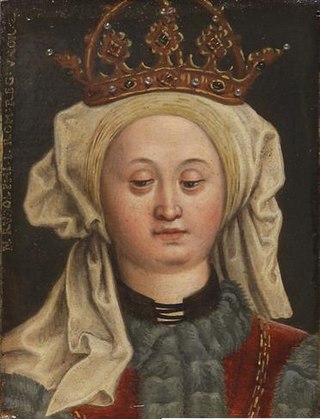
The House of Bourbon is a dynasty that originated in the Kingdom of France as a branch of the Capetian dynasty, the royal House of France. Bourbon kings first ruled France and Navarre in the 16th century. A branch descended from the French Bourbons came to rule Spain in the 18th century and is the current Spanish royal family. Further branches, descended from the Spanish Bourbons, held thrones in Naples, Sicily, and Parma. Today, Spain and Luxembourg have monarchs of the House of Bourbon. The royal Bourbons originated in 1272, when Robert, the youngest son of King Louis IX of France, married the heiress of the lordship of Bourbon. The house continued for three centuries as a cadet branch, serving as nobles under the direct Capetian and Valois kings.

Eudes III, commonly known in English as Odo III, was duke of Burgundy between 1192 and 1218. Odo was the eldest son of duke Hugh III and his first wife Alice, daughter of Matthias I, Duke of Lorraine.

Hugh IV of Burgundy was Duke of Burgundy between 1218 and 1272 and from 1266 until his death was titular King of Thessalonica. Hugh was the son of Odo III, Duke of Burgundy and Alice de Vergy.

Auxonne is a commune in the Côte-d'Or department in the Bourgogne-Franche-Comté region of eastern France.

Charles IV was Duke of Lorraine from 1624 until his death in 1675, with a brief interruption in 1634, when he abdicated under French pressure in favor of his younger brother, Nicholas Francis.

The House of La Trémoïlle(Maison de La Trémoille in French) was a French noble family from Poitou whose name comes from the village La Trimouille in the department of Vienne. This family has been known since the middle of the 11th century, and since the 14th century its members have been conspicuous in French history as nobles, military leaders and crusaders, and influential as political leaders, diplomats, Huguenots and courtiers. The male line of the family died out in 1933, while female line heirs of the last duke have kept the La Trémoïlle surname alive in Belgium.

Isabella of Burgundy, Lady of Vieux-Château, was the second and last Queen consort of Rudolf I of Germany.

Genlis is a French commune in the Côte-d'Or department. The 20th-century archaeologist Jean Charbonneaux (1895–1969) was born in Genlis.

The House of Blois was a noble family that arose in the Kingdom of West Francia in the early 10th century, and whose prominent members were often named Theobald.

The House of Vergy is one of the oldest French noble families, a cadet dynasty related to the 5th century Merovingian Kingdom of Burgundy, attested since the 9th century.

Alicede Vergy (1182–1251) was Duchess of Burgundy as the second spouse of Odo III, Duke of Burgundy. She was the regent of Burgundy during the minority of her son 1218–28.
François Marie de Lorraine was a French nobleman and member of the House of Lorraine. He was known as the prince de Lillebonne. He was also the Duke of Joyeuse.

Béatrix de Cusance, Baroness of Belvoir, was the second wife of Charles IV, former reigning Duke of Lorraine. She was a correspondent of Constantijn Huygens.
Hugh I, of Ghent was lord of Heusden, Bornhem, and Saint-Jean Steene, Chatelain of Ghent. Hugh was the eldest child of Zeger III of Ghent and Beatrix of Heusden.
Jacques de Clermont d'Amboise was the third son of Louis de Clermont, Lord of Gallerande, butler of the king, and Renée d'Amboise.
The Counts of Dammartin were the rulers of the county of Dammartin, based in the current commune of Dammartin-en-Goële as early as the 10th century. Located at the central plain of France, the county controlled the roads of Paris to Soissons and Laon. It seems that this county was initially held by Constance, the wife of Manasses Calvus, the first Count. The name Dammartin-en-Goële comes from Domnus Martinus, the Latin name of St. Martin of Tours, who evangelized the region of Goële in the fourth century. A small town in the district of Meaux in the Department of Seine-et-Marne, ancient village of Region of Île-de-France, it appears to go back to the earliest times; Dammartin-en-Goële, also called Velly, was in 1031 one of the most significant places in France.
Odo/Eudes I de Champlitte the so-called Champenois, of the House of Blois and its cadet branch, the house of Champlitte. was Lord of Champlitte, Viscount of Dijon, and also a claimant to the title of Count of Champagne. He was the son of Hugh, Count of Champagne, Count of Champagne and Isabella of Burgundy, daughter of Stephen I, Count of Burgundy.
















